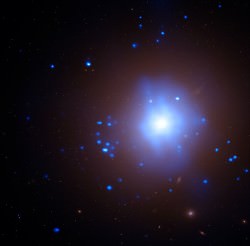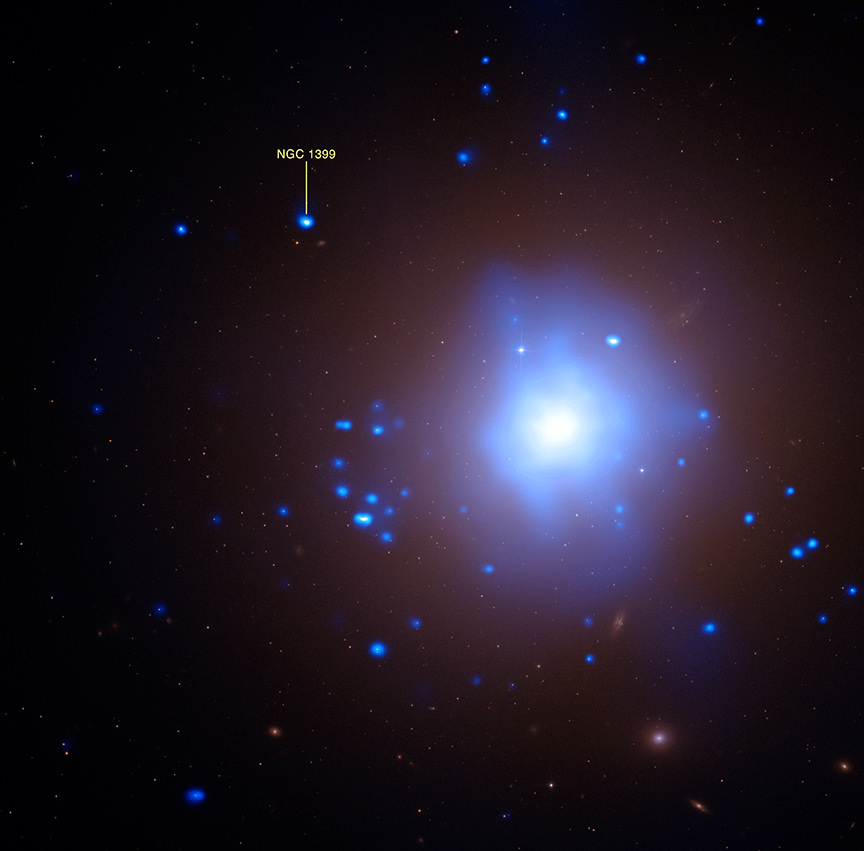NGC 1399, an elliptical galaxy about 65 million light years from Earth. Credit: NASA, Chandra
A dense stellar remnant has been ripped apart by a black hole a thousand times as massive as the Sun. If confirmed, this discovery would be a cosmic double play: it would be strong evidence for an intermediate mass black hole — which has been a hotly debated topic — and would mark the first time such a black hole has been caught tearing a star apart. Scientists believe a mysterious intense X-ray emission, called an “ultraluminous X-ray source” or ULX is responsible for the destruction. “Astronomers have made cases for stars being torn apart by supermassive black holes in the centers of galaxies before, but this is the first good evidence for such an event in a globular cluster,” said Jimmy Irwin of the University of Alabama, who led the study.
The new results come from the Chandra X-ray Observatory and the Magellan telescope, and were announced at the 215th American Astronomical Society meeting today.
The scenario is based on Chandra observations, which revealed the ULX in a dense cluster of old stars, and optical observations that showed a peculiar mix of elements associated with the X-ray emission. Taken together, a case can be made that the X-ray emission is produced by debris from a disrupted white dwarf star that is heated as it falls towards a massive black hole. The optical emission comes from debris further out that is illuminated by these X-rays.
The intensity of the X-ray emission places the source in the category, meaning that it is more luminous than any known stellar X-ray source, but less luminous than the bright X-ray sources (active galactic nuclei) associated with supermassive black holes in the nuclei of galaxies. The nature of ULXs is a mystery, but one suggestion is that some ULXs are black holes with masses between about a hundred and several thousand times that of the Sun, a range intermediate between stellar-mass black holes and supermassive black holes located in the nuclei of galaxies.

This ULX is in a globular cluster, NGC 1399, an elliptical galaxy about 65 million light-years from Earth that is a very old and crowded conglomeration of stars. Astronomers have suspected that globular clusters could contain intermediate-mass black holes, but conclusive evidence for this has been elusive.
Irwin and his colleagues obtained optical spectra of the object using the Magellan I and II telescopes in Las Campanas, Chile. These data reveal emission from gas rich in oxygen and nitrogen but no hydrogen, a rare set of signals from globular clusters. The physical conditions deduced from the spectra suggest that the gas is orbiting a black hole of at least 1,000 solar masses. The abundant amount of oxygen and absence of hydrogen indicate that the destroyed star was a white dwarf, the end phase of a solar-type star that has burned its hydrogen leaving a high concentration of oxygen. The nitrogen seen in the optical spectrum remains an enigma.
“We think these unusual signatures can be explained by a white dwarf that strayed too close to a black hole and was torn apart by the extreme tidal forces,” said coauthor Joel Bregman of the University of Michigan.
Theoretical work suggests that the tidal disruption-induced X-ray emission could stay bright for more than a century, but it should fade with time. So far, the team has observed there has been a 35% decline in X-ray emission from 2000 to 2008.
Irwin said at today’s press conference that a new survey just getting started will look for more globular clusters with x-ray sources.
Sources: Chandra, AAS Meeting


Something about that labeled photo at the top looks odd. It appears someone got their labels mixed up. The Chandra page notes this image is a composite Hubble and Chandra image of NGC 1399. The brightest object in the frame is NGC 1399. The blue star-like images are (mostly) X-ray bright globular clusters orbiting NGC 1399 which is located in the Fornax Galaxy Cluster. The labeled object is the ULX itself ( http://chandra.harvard.edu/photo/2010/ngc1399/ngc1399_labeled.jpg ). NGC 1399 is known to have a large number of globular clusters, probably from galaxies it cannabalized in the past.
The Hubble ACS(?) image of the galaxy shows a portion of the swarm of globulars surrounding it ( http://chandra.harvard.edu/photo/2010/ngc1399/ngc1399_optical.jpg ). What a sight this must be for observers in NGC 1399. It would be a sky full of globular clusters! 🙂
You are right Jon.
This photo http://www.eso.org/public/images/eso9405a/
-shows some of the very faint planetary nebulae in the giant elliptical galaxy NGC 1399.
This is also old news, it was already published in 2006 – “A Comparison of Ultraluminous X-Ray Sources in NGC 1399 and the Antennae Galaxies (NGC 4038/4039)
Hua Feng et al 2006 ApJ 653 536-544”
The most luminous ULX, X-16, with a very hard spectrum (? = 1.0-1.3) and a luminosity that varies by a factor of 10, could be an IMBH candidate.
Btw, NGC 1399 has a diameter of about 130.000 light years.
I presume the time dependent spectrum of radiation from a white dwarf being distentded like this has been phenomenologically calculated or estimated.
LC